The Russians are still proud of their soldiers, the slayers of the fascist beast. According to propaganda messages, the Red Army soldiers are efficient, formidable, well-trained warriors. What was it really like?
Conscription to the Red Army was dealt with by district replenishment commands. The first activity that was performed in the unit was to send a conscript to ... a sump, i.e. a steam bath. It was only after he had washed himself that the disinfection of clothes, haircut and obligatory political lecture were carried out.
Consumption or "sucks" to "sucks"
Bania was an integral part of the conscription, not only as a place where hygiene was taken care of. The future Red Army bunker often reached the mother unit completely flooded. He was so sucked that he didn't remember much of what was happening to him back then. It was an old tradition, from the tsarist army, and the officers looked at it through their fingers. According to them, vodka eliminated the fear of the army, and a drunk delinquent could be dragged to the barracks easier.
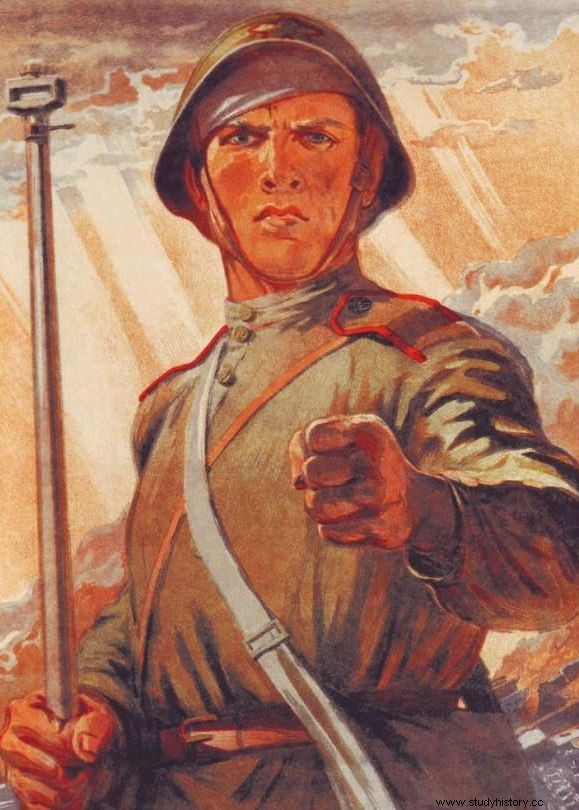
On the propaganda posters, the Red Army soldiers were depicted as dangerous warriors. The reality, however, was quite different (source:public domain).
Uniforms were packed on the spot for recruits:woolen trousers, a sweatshirt, belt, shoes and a coat. Fresh underwear in the form of a T-shirt and underpants was issued only occasionally. Instead of socks, everyone was awarded onuka, sheets of fabric of the same size for both women and men. As one soldier later said: only thanks to onucom, our shoes fit us. And we were so glad to have shoes at all.
Statistical Conscript
The nightmare of the Soviet army was the catastrophic level of education of the soldiers. The future private was usually illiterate. In the late 1920s, it was discovered that the dictionary used by soldiers was as low as 500 to 2,000 words. The shocked political management also established that among the newly minted defenders of communism there are also those who had no idea ... who comrade Stalin was!
The level of education of the future officers was also pathetic. In January 1939, the percentage of elves with no or only elementary education was 68.5% in infantry and 85% in armored units. As if that were not enough, 37-39% of line officers had no military training at all! Of course, all of them had to have an appropriate proletarian origin ...
Accommodation, soldier, you will arrange it here
In the years 1938-1939, the army grew rapidly. However, no one took care of securing the living needs of the new soldiers. The barracks lacked such basic things as beds or even spoons. As a result, the Red Army cared for everyday objects almost as much as for their own lives ...
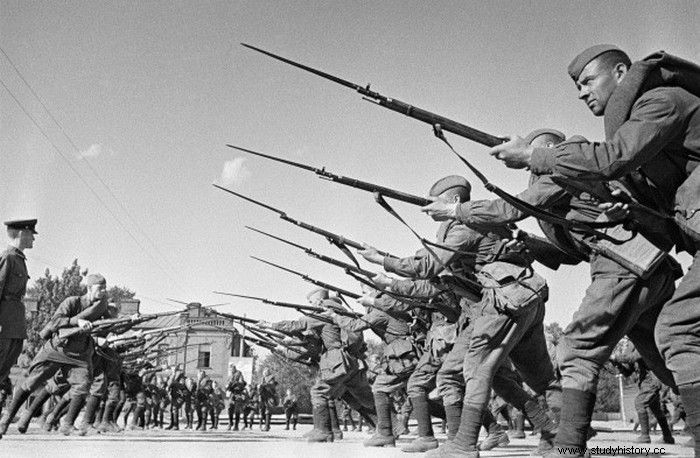
The real bane of the Red Army was the terrible education of the conscripts and the officer cadre (source:RIA Novosti archiv; photo by Anatoliy Garanin; license CC ASA 3.0).
One of the veterans mentioned that: front soldiers sometimes had to abandon heavy rifles during panic retreats, but never spoons . Beds, if they existed at all, often had nowhere to place for the simple reason that there were no barracks! The soldiers themselves had to build new quarters for themselves.
A regiment should have been adopted - wrote General Ivan Chistiakov - to build makeshift living quarters, a canteen and a stable in an empty space. Red Army soldiers were digging dugouts and putting up roofs. They brought stones and built barracks for five hundred people.
Accommodation in normal garrison buildings was considered a luxury. Even then, the soldiers did not know how to use these advantages. The Germans mentioned the ubiquitous mess and dirt in the captured Soviet barracks buildings.
Lieutenant Horst Slesina, a propaganda officer of the German army, in his collection of reports "Soldiers against death and the devil" describes a situation when his unit intended to spend the night in "perfectly new and modern" Soviet barracks:
There is an incredible stench in the rooms. In large dormitories, furniture is made of untreated wood, and while it looks new, it is covered with a thick layer of dirt. On the floor, a layer of trampled rubbish forms a thick, slippery layer.
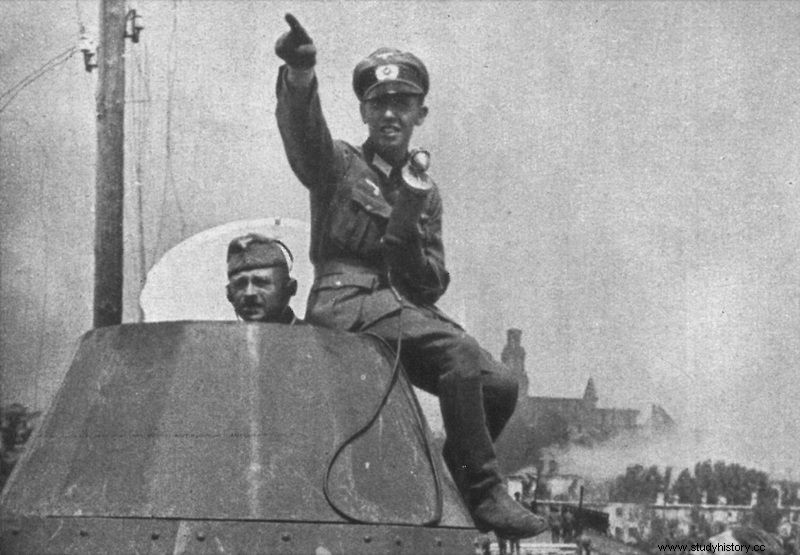
Horst Slesina during a radio broadcast from the front. Photo from the book "Soldiers against death and the devil."
The situation was just as tragic in places reserved for married professional officers, commissioners and officials. Showers do exist, but it seems no one has ever used them. They have been converted into small warehouses for coal and potatoes. I can't describe the toilet. They were so dirty and clogged that they were nailed down.
Hygiene
The reports of Soviet officers who carried out inspections of various garrisons in 1939 also confirmed this state of affairs. One of them described bathrooms and toilets:
overflowing latrine trays are not removed, and the surviving toilets have no lids. The urinals are broken (…). Well, the unit doesn't have a latrine . The second report was in a similar vein: nobody picked up garbage, nobody cleaned up. Broken urinals. The sewage system in the officer's wardroom is down.
The personal hygiene of the soldiers looked desperate. There was no soap. Since there was no toothpaste, many soldiers never brushed their teeth. They only took a bath if there was running water and the bathrooms were working. The situations were saved by the aforementioned bananas, but these were usually available in cities. Some soldiers mentioned that they get confused every two weeks, others that not more than once a month. The lice infestation was the order of the day.
Food
It may seem absurd, but the army that had more tanks than all the armies of the world combined had problems feeding its troops. The ritual food was scarce and of poor quality.
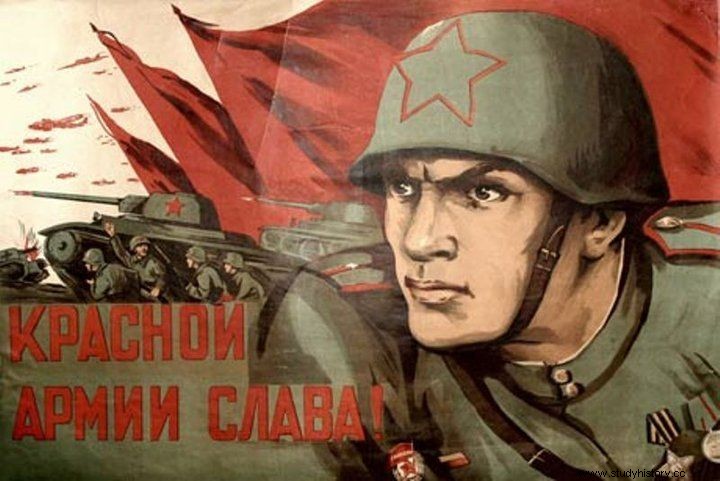
Maybe the Red Army had the most tanks in the world, but what if it had huge problems even with feeding its soldiers? (source:public domain).
The soup often turned out to be watery lure with pieces of wormed meat. In addition, they served tar-black bread and a drink that could only be called tea in a fit of good mood. Some soldiers also disgusted with the often served cabbage soup.
Spoiled food was the source of massive stomach ailments. It happened that entire regiments were hospitalized for this reason. Soldiers often rioted and refused to eat.
In order to remedy the situation, individual units coped with their own expense. Red Army soldiers kept rabbits, pigs and even cows, they also grew crops and potatoes. Indeed, it was sometimes difficult to distinguish a military unit from a collective farm!
Training
Combat training in the Red Army was pure fiction. The recruits were first of all tried to inculcate a military drill to force them to obey. When it comes to learning how to use weapons and military equipment, the situation was embarrassing. For the soldiers, even such basic armament as the Mosin rifle was lacking. So they learned how to build and operate a rifle without a rifle.
The smarter commanders assigned the soldiers wooden replicas to at least teach them the basic holds of weapons. The effect of these efforts was such that when the Red Army soldiers were sent to Finland, up to 30% of the soldiers were unable to operate the infantry rifle!
It was no better in the armored forces. Military school graduates were not taught to read maps or use a compass because it was too difficult for them to understand. To future commanders, the word "azimuth" sounded like a magic spell. They could not even properly give orders to their crew, let alone any coordination when fighting with other troops.
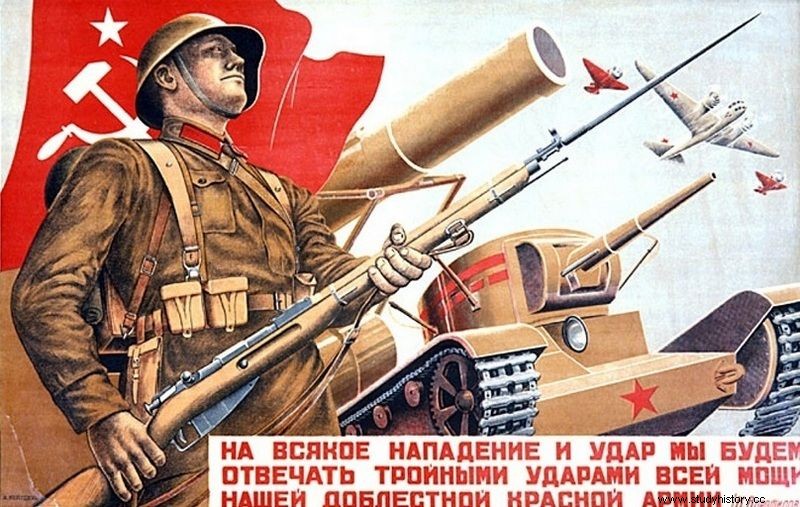
Contrary to the vision created by propaganda at the turn of the 1930s and 1940s, there was no question of any concerted interaction of various types of Soviet troops (source:public domain).
Tankers felt uncomfortable when they had to operate such "technical novelties" as radio stations. They considered them to be an unreliable device. For this: the microphone on the chest interferes with work, it gets tangled, and there is no time to deal with tuning and switching . But that wasn't the greatest absurdity at all.
When in 1938 new stabilized gun sights were installed on the then Soviet T-26 tanks, it quickly turned out that they had to be returned to the warehouse. Reason: difficulties in mastering their operation by the staff !
